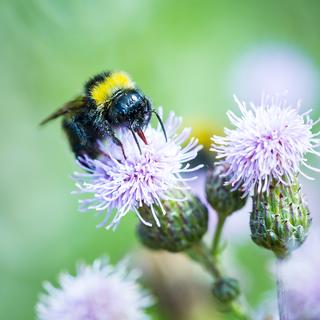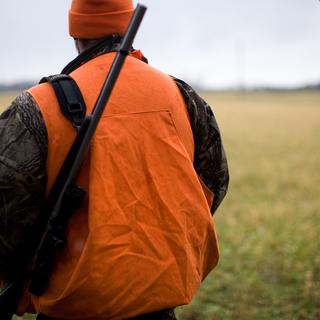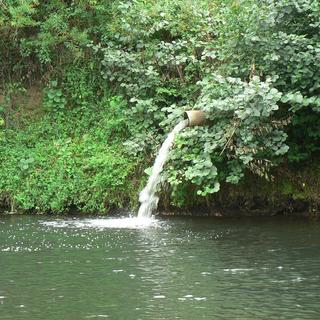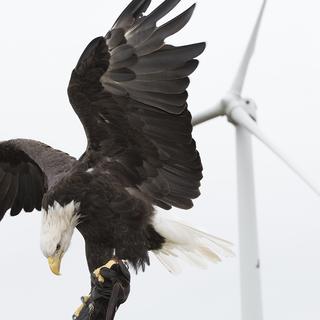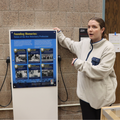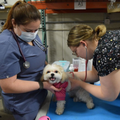Minnesota legislators authorized nearly $3.7 million for eight veterinary-related research and education projects that will begin over the next two years. The projects involve numerous College of Veterinary Medicine faculty and collaborators, who will collectively improve the health of animals, humans, and the environment.
Of the funding, $1.37 million for chronic wasting disease (CWD) research was provided by the Clean Water Fund as recommended by the Clean Water Council. The remaining $2.3 million was provided by the Environment and Natural Resources Trust Fund as recommended by the Legislative Citizens Commission on Minnesota Resources.
Protecting Minnesota’s native bumblebees
Among the well-documented causes of the decline in global bee populations—habitat loss, pesticides, parasites—is a lesser-understood but significant threat: pathogens. There’s evidence a disease called deformed wing virus (DWV), most often found in honeybees, may transmit to bumblebees if a diseased honeybee leaves the virus on a flower that a bumblebee later visits. Currently, not much is known about how prevalent pathogens are in Minnesota bumblebees. Adding to the concern: five of Minnesota’s 23 species of native bumblebees are considered by the International Union for Conservation of Nature to be vulnerable, endangered, or critically endangered. That’s why the LCCMR has awarded Declan Schroeder, PhD, in the Department of Population Medicine, and his team $650,000 to collect and analyze data on archetypal bumblebee pathogens in local populations, and then embark on a pilot study to attempt to neutralize DWV transmission to the species. By screening and neutralizing bee pathogens, Schroeder and his team hope to promote best management practices to maintain honeybee health and prevent pathogen spillover into native bumblebee populations. The project will run through June 2024.
Hunter education promotes use of non-toxic ammunition
A new hunter education program approved and funded with $261,000 from Minnesota’s Environment and Natural Resources Trust Fund seeks to inform deer hunters about non-toxic ammunition choices, such as copper bullets. The program will be coordinated by The Raptor Center at the University of Minnesota with support from a coalition of conservation and hunting groups across the state and will provide information regarding the safety, effectiveness, quality, and competitive pricing of non-lead ammunition currently available. The program will offer workshops that include training, hands-on demonstrations modeling how different types of bullets fragment when fired, and opportunities for hunters to test non-toxic ammunition. Information regarding the topic will be added to youth firearm safety classes and hunter education courses as well as presented at large, hunting-focused events held in the state. Reducing the use of toxic ammunition is expected to help decrease unintended wildlife deaths—particularly raptors—which can occur when animals ingest lead fragments while feeding on gut piles left from field dressing large game.
Microbiome in raptors: A new tool for conservation
The Raptor Center (TRC) is renowned for its treatment of birds in rehabilitation. Now, the center intends to learn what impacts that treatment has for raptor health and the wider natural ecosystem upon reintroduction. Thanks to $129,000 in new Environment and Natural Resources Trust Fund dollars, as recommended by the Legislative-Citizen Commission on Minnesota Resources Julia Ponder, DVM, MPH, Elizabeth Miller, PhD, and Irene Bueno Padilla, PhD, MPH, DVM, will identify the microbiome from samples taken from the gut of healthy raptors captured in the wild and from injured raptors of the same species brought to TRC. They will investigate whether the use of antimicrobials and probiotics in captivity alter the microbiome—and attempt to better understand the emergence and spread of antimicrobial resistance (AMR) in the environment. There’s a critical gap in AMR research this study would fill: AMR is one of the big public-health challenges of this century—and it’s well documented birds are a primary disseminator—but the impact of AMR on ecosystems remains largely understudied. Researchers hope their findings will become a tool to tailor treatment for raptor rehabilitation—which would improve conservation. They also endeavor to shed some light on how changes to the gut microbiome may contribute to the dissemination of AMR in natural environments. The project is expected to run through June 2023.
Microgeographic impact of antibiotics released from identified hotspots
More than 50 percent of antibiotic compounds used in hospitals, long-term care facilities, and animal husbandry facilities may be released into the environment, though the extent of their subsequent travel is not well understood. What is known is this unmitigated discharge plays a role in the emergence of antimicrobial resistance (AMR), one of the leading modern threats to animal, human, and ecosystem health. Now, a group of researchers including Randall Singer, DVM, PhD, and Irene Bueno Padilla, DVM, PhD, in the Department of Veterinary and Biomedical Sciences, will use $508,000 in LCCMR funding to study antibiotic residue concentrations near point sources like hospitals and wastewater treatment facilities to better understand the correlation between antibiotic prescription over time and the concentrations of its residue in the environment—including how far antibiotic residue travels. Through this detailed study at a microgeographic scale, the team hopes to use their findings to help establish mitigation strategies at point sources to minimize the ill health effects caused by AMR.
Expanding access to environmental education
Subjects such as math and English are common components of school curriculums, but The Raptor Center wants to expand access to environmental education for Minnesota schools and provide teachers with access to resources and tools supporting this topic. A program aimed at doing just that has received $178,000 from the state’s Environment and Natural Resources Trust Fund. In an effort to build environmental literacy and engagement in the classroom, this integrated environmental education program would bring a standards-based curriculum and educational animal ambassadors—in this case, raptors—to underserved communities throughout Minnesota. The live bird programs will be taught by highly skilled environmental educators and engage students in learning about environmental issues and solutions. The program also would provide teachers with an appropriate age-based curriculum and supporting materials. The two-year project is expected to bring a live raptor program to 300 classrooms in underserved communities throughout the state, with an expected reach of 20,000 to 30,000 students.
Behavioral Response of Bald and Golden Eagles to Acoustic Stimuli
For all the benefits wind energy provides, there’s a notable drawback: federally protected bald and golden eagles sometimes fatally collide with turbine blades. With $261,000 in assistance from the Environment and Natural Resources Trust Fund—as recommended by the Legislative-Citizen Commission on Minnesota Resources—University researchers from the St. Anthony Falls Laboratory and The Raptor Center, including Julia Ponder, DVM, MPH, expect to fill a significant research gap on the effects of acoustic deterrent devices, a promising method to reduce eagle collisions. The researchers will expose eagles to an array of natural and synthetic stimuli in controlled environments and log behavioral responses to develop an ideal acoustic deterrent that would result in an eagle veering from its flight path. The team hopes findings will for the first time provide acoustic deterrent system designers and developers a solid foundation upon which to confidently build new technologies. The project is expected to run through June 2023.
Environmental Assessment of CWD Prions at the Beltrami County Deer Carcass Dumpsite
When a deer carcass dumpsite was discovered in Beltrami County in late April, a myriad of stakeholders held their breath and awaited news from University researchers as to whether the always fatal chronic wasting disease (CWD) would be confirmed for the first time on land outside of a deer farm in the reaches of northern Minnesota, just to the west of the Chippewa National Forest. Days later, news came: one of the initial samples tested positive. It’s during emerging disease flashpoints like this that the unique value of the LCCMR is brought to bear in service of the health of Minnesota’s wildlife, natural environment, and economy. The commission nimbly awarded $108,000 in emergency funds to the Minnesota Center for Prion Research and Outreach (MNPRO) to collect, test, and analyze the full scope of the dumpsite remains. The LCCMR knew right where to turn: MNPRO experts have been blazing the trail in CWD research and testing, having developed novel forensic testing methods that allow scientists to detect the disease more efficiently than ever before. That expertise is crucial now, as the center and other state and local agencies crucial to the fight mitigate any potential spread in those idyllic Beltrami pine forests and wetlands.
Chronic Wasting Disease Prion Research in Soils and Waterways
What started as a grassroots movement in 2019 to assist the state in chronic wasting disease mitigation has grown into a leader in CWD research and outreach. Now, thanks to $1.72 million in new state funding, the Minnesota Center for Prion Research and Outreach will embark on a novel, multidisciplinary initiative to understand how chronic wasting disease is transported in Minnesota soils and waterways. The team of researchers and scientists will employ novel detection tools it has developed in an effort to characterize, forecast, and remediate prion contamination of Minnesota’s waterways, soils, and plants. The project will have significant impacts on not only animal and human health, but on local and statewide economies to which CWD represents a multi-billion dollar threat. MNPRO has assembled a research team with expertise in hydrology, soils, epidemiology, plant biology, and molecular biology—and the team will work with state watershed districts, citizens, and other partners in its efforts to confront the multifaceted health and economic issues CWD poses.


